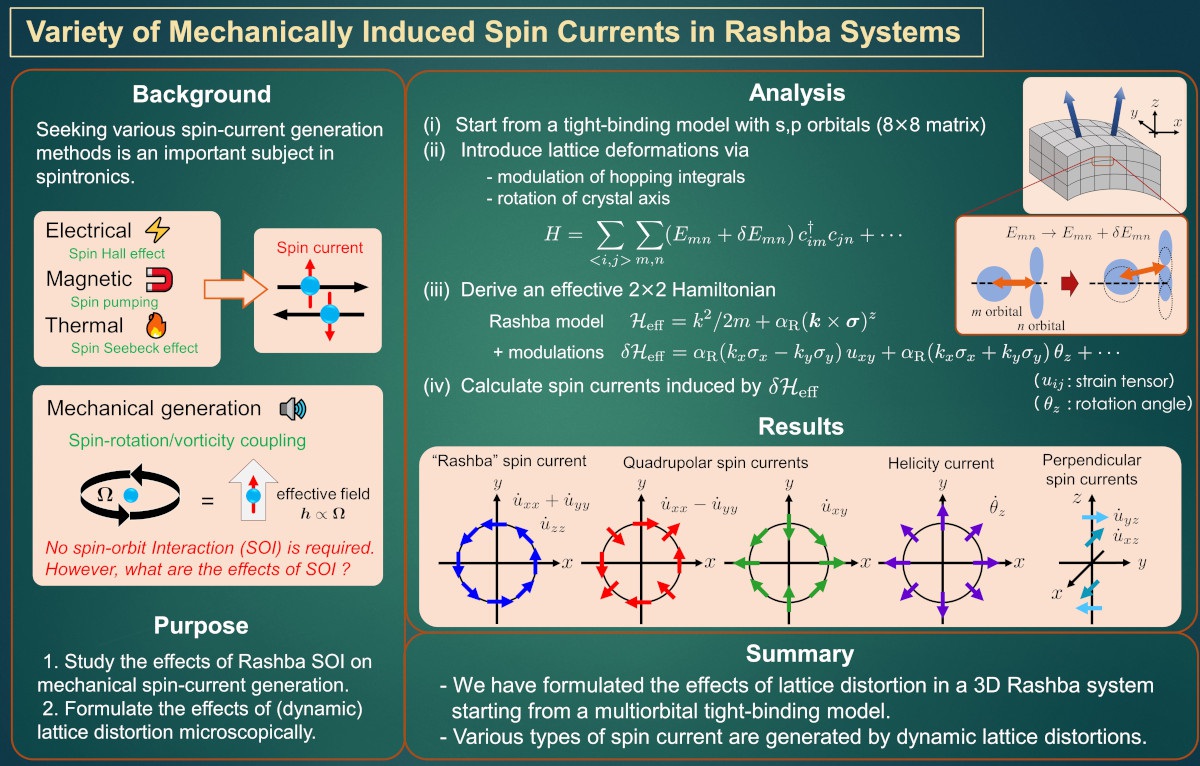Variety of Mechanically Induced Spin Currents in Rashba Systems
© The Physical Society of Japan
This article is on
J. Phys. Soc. Jpn.
92,
113702
(2023)
.
Various types of spin currents, including unconventional types, are generated in Rashba spin-orbit coupled systems by dynamic lattice distortions associated with, for example, surface acoustic waves.

Spin current, the flow of spin angular momentum, is a central element in spintronics for future technological applications. Thus, elucidating various mechanisms to generate spin currents is an important topic. Since the discovery of the gyromagnetic effect more than 100 years ago by Einstein, de Haas, and Barnett, spin angular momentum has been known to be mutually converted with the mechanical angular momentum associated with rotational motion of materials. This suggests that spin currents can be generated mechanically. Present-day experiments have shown that spin currents are generated by shear flows in liquid metals and by surface acoustic waves in solids.
The electron spin also interacts with its orbital motion through relativistic effects, that is, the spin-orbit interaction (SOI). The SOI is responsible for various spin-current generation methods because it bends the electron orbits in spin-dependent directions. In particular, the Rashba SOI appears in systems with broken spatial inversion symmetries, such as at the surfaces and interfaces of materials. When generating spin currents using surface acoustic waves, the effects of Rashba SOI may be utilized.
In this study, we investigated spin-current generation from dynamic lattice distortions in systems with Rashba SOI. Unlike prior theoretical studies, we started from a multiorbital tight-binding model to derive a Rashba model perturbed by lattice distortions. This method enabled us to treat the lattice distortion effects microscopically through the modulation of hopping integrals and local rotation of the crystal axes. By calculating the linear response to the effective perturbations, we observed that surface acoustic waves can generate a variety of spin currents through the Rashba SOI, including unconventional spin currents, such as the quadrupolar spin current, perpendicular spin current, and helicity current.
Written by Y. Ogawa on behalf of all authors.
J. Phys. Soc. Jpn.
92,
113702
(2023)
.
Share this topic
Fields
Related Articles
-
Qualitative Changes in Kinetic Pathways Driven by Hydrodynamic Interactions in Dense Colloidal Suspensions
Cross-disciplinary physics and related areas of science and technology
Statistical physics and thermodynamics
Structure and mechanical and thermal properties in condensed matter
2025-4-18
Even in dense colloidal suspensions, where long-range hydrodynamic interactions are screened, near-field hydrodynamic interactions qualitatively influence the selection of kinetic pathways.
-
Higher-Order Topological Phases in Magnetic Materials with Breathing Pyrochlore Structures
Electronic structure and electrical properties of surfaces and nanostructures
Magnetic properties in condensed matter
Mathematical methods, classical and quantum physics, relativity, gravitation, numerical simulation, computational modeling
2025-4-7
A simple example of a higher-order topological phase, in which the symmetry decreases step-by-step from the bulk to the corner, is realized in a magnetic system with a pyrochlore structure and is characterized by a series of quantized Berry phases defined for the bulk, surface, and edge.
-
Existence of Chiral Soliton Lattices (CSLs) in Chiral Helimagnet Yb(Ni1-xCux)3Al9
Magnetic properties in condensed matter
2025-4-1
Our study examines the magnetic structure of the monoaxial chiral helimagnet Yb(Ni1-xCux)3Al9, providing first direct evidence of the formation of chiral soliton lattice state.
-
Understanding Pressure-Induced Superconductivity in CrAs and MnP
Magnetic properties in condensed matter
2025-3-10
This study reviews existing research on the pressure-induced variation of magnetic properties of transition metal mono-pnictides like CrAS, MnP, and others, aiming to understand the unconventional superconductivity observed in CrAs and MnP.
-
A Unified Theory of Topological Hall Effect
Electronic transport in condensed matter
2025-3-6
This paper presents a unified theoretical description for the topological Hall effect, covering the entire region from strong- to weak-coupling, extending its picture beyond the Berry phase.




